
Manaslu Circuit Trek is an adventurous Himalayan trekking experience that takes you on remote and isolated trails away from the mainstream trekking crowd. This exciting Himalayan trekking adventure takes you on an unforgettable journey across the charming foothills of the eighth-highest snow-clad mountain in the world, Mt. Manaslu [8,163 meters/ 26,781 feet].
This remarkable exploration is certainly a marvelous exploration prospect throughout the year. However, did you know that the Manaslu Circuit Trek in March creates a perfect window frame to reap the perks of two peak seasons?
The month of March, which is right after the winter season, adds unique prospects to this exciting trek for you to witness the magnificence of the west-central Himalayan region in a different color. You will be able to enjoy the climatic benefits of the mild temperatures like autumn, enjoy the stunning visuals of the blooming of the spring, and, of course, witness the astonishing winter landscape covered with snow blanket slowly transiting to the lush greeny as the spring gradually takes over.
If you are a Himalayan trekking enthusiast, you cannot simply miss this exciting adventure in this month that offers the unique variation that trekkers have to travel in three seasons to experience.
Trek Overview- Manaslu Circuit Trek in March

Manaslu Circuit Trek generally lasts for about 14 to 18 days; the duration of the package may vary depending on the itinerary plans and the exploration part. Some packages include a sightseeing day at Kathmandu, while others start with the drive directly to Soti Khola [730 meters/ 2,395 feet], Machha Khola [930 meters/ 3,051 feet], or Jagat [1,410 meters/ 4,625 feet].
Depending on the drive destination, your trekking adventure will either start from Jagat or at an earlier point in the route. Then, moving further with your uphill trekking route, you will trek to Deng [2,130 meters/ 6,988 feet] via Philim [1,570 meters/ 5,150 feet]. The trekking route further ahead leads to other high-elevation destinations like Namrung [2,700 meters/ 8,858 feet], Lo Gaon [3,180 meters/ 10,433 feet], Sama Gaon [3,530 meters/ 11,581 feet], Samdo [3,690 meters/ 12,106 feet], and Dharmashala [4,470 meters/ 14,665 feet].
Then, you will traverse across the Himalayan Pass, Larke La Pass [5,106 meters/ 16,751 feet], and move along with your circumnavigating descending journey. During your downhill trek, you will pass through the popular highlights in the Manaslu region, like Bhimthang [3,790 meters/ 12,434 feet], Tilje [2,300 meters/ 7,545 feet], Dharapani [1,725 meters/ 5,659 feet], and Syange [1,100 meters/ 3,608 feet] before driving back to Kathmandu.
Highlights of Manaslu Circuit Trek in March
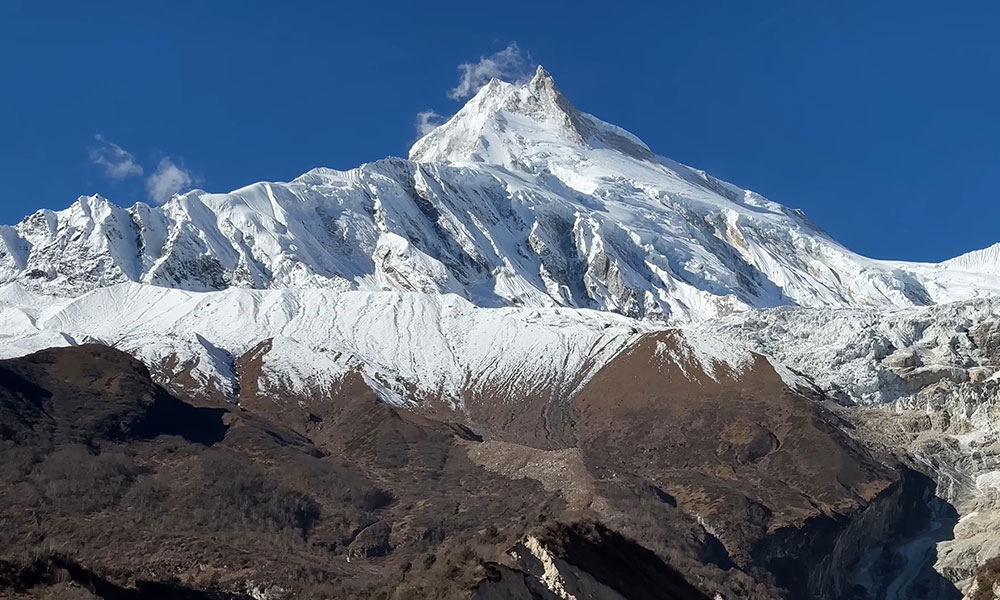
Mild Climatic Conditions
The month of March starts right after February, the end of the winter season in is known for its mild climatic conditions. The temperature of the Manaslu region during this month is quite mild and almost similar to the weather conditions of the autumn season. The temperature of Manaslu usually averages around 10°C to 20°C during the daytime and can drop up to -6°C at night.
This is the perfect temperature for outdoor adventures for less sweaty treks. The fresh and crisp breezes will keep you refreshed throughout your trekking adventure. Thus, if you do the Manaslu Circuit Trek in March, you will be able to reap the climatic benefits of the autumn season and the scenery of the spring season.
Clear Mountain Views
With the start of the spring season during the month of March, the weather starts to get stable and the days clearer. So, during your Manaslu Circuit trek in March, you will be able to enjoy the magnificent views of the surrounding Himalayan peaks. Due to the low precipitation in this month, the days are usually clear, and you can catch clear views of the Himalayan vistas during without any obstruction.
During this trek, you will be able to witness the up-close magnificence of the Himalayan peaks, like Manaslu, Shringi Himal, Annapurna II, Peak 29, Ganesh Himal, Himalchuli, Cheo Himal and other adjacent peaks.
Less Crowded Trekking Route
Although the spring season sees a peak crowd of trekkers among all other seasons due to its fascinating natural allurements, the trekking trails in the March season are not that crowded. As this month is right behind the winter season, it is relatively colder at the alpine altitude during the early morning and night time.
Due to the lingering cold of the winter season during the early part of the month, most trekkers prefer trekking during the mid-spring season. So, you will be able to enjoy a trekking experience on a less crowded route if you do the Manaslu Circuit Trek in March. The quieter trails mean that you will have more opportunities to enjoy the solitude and have a more intimate connection with nature.
Diverse Terrains
The spring season is known as nature’s paradise. During this season, the diverse and colorful vegetation takes over the Himlayan region. You will be greeted with colorful rhododendron flowers, wildflowers, and lush forested trails during your Manaslu Circuit Trek in March.
However, there is still more to the alluring landscapes of the region during the month of March. As this month is the transition point for the winter-to-spring landscapes, you might also get the opportunity to witness the magical moments where the bloom of the spring gradually melts and takes over the snow-clad landscapes.
Incredible Photography Opportunities
Due to the phenomenal natural prospects of this peak season of nature, the photography opportunities in this month are quite boundless. The bright-stunning visuals of the spring season cover landscapes with colorful flowers, and due to the clear climate, you can catch a wide glimpse of the Himalayan vistas as far as your eyes can reach.
Similarly, it is also the most suitable time period for wild photography. During the month of March, the wildlife of the region slowly starts to leave their shells of hibernation, and the colorful migratory birds from all over the world start to flock in to taste the nectar of nature. So, during your Manaslu Circuit trek in March, you will be able to capture the most incredible sight of nature with your lens.
Difficulty Level of the Trek in March
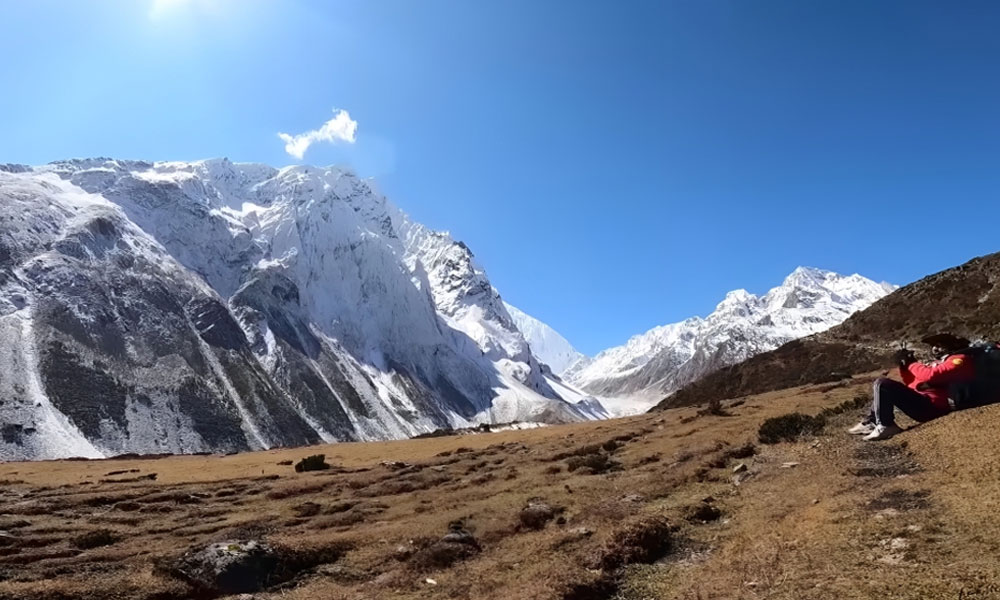
The Manaslu Circuit Trek is one of the easier trekking adventures in the Himalayan region. This trek has an overall ‘mild/moderate’ difficulty level. You don’t spend a significant amount of time at the alpine altitudes, and the trekking trails are not strenuous.
If you want to do this trek, you don’t need any prior trekking experience, as there are no technical sections along the trail. However, it doesn’t mean that this Himalayan exploration will be easy, like the hikes in the backyard.
The Manaslu Circuit Trek is around 177 km (110 miles) long. Although the trekking distance may differ depending on the route and exploration of the highlights of the region, you will still have to cover a significant distance during your adventure (about 6-7 hours of trekking each day).
Likely, although the elevation points of this adventure are not as strenuous as other high-altitude treks, you will still climb to major altitudes in this adventure. Beginning your trek from either Soti Khola (730 meters) or Machha Khola (930 meters), you will reach the highest altitude in this adventure at Larke La Pass (5,106 meters).
Still, the difficult factors of this adventure are not that challenging, and you will be able to easily overcome them with preparation and the right precautionary steps.
How Do I Prepare for the Trek?
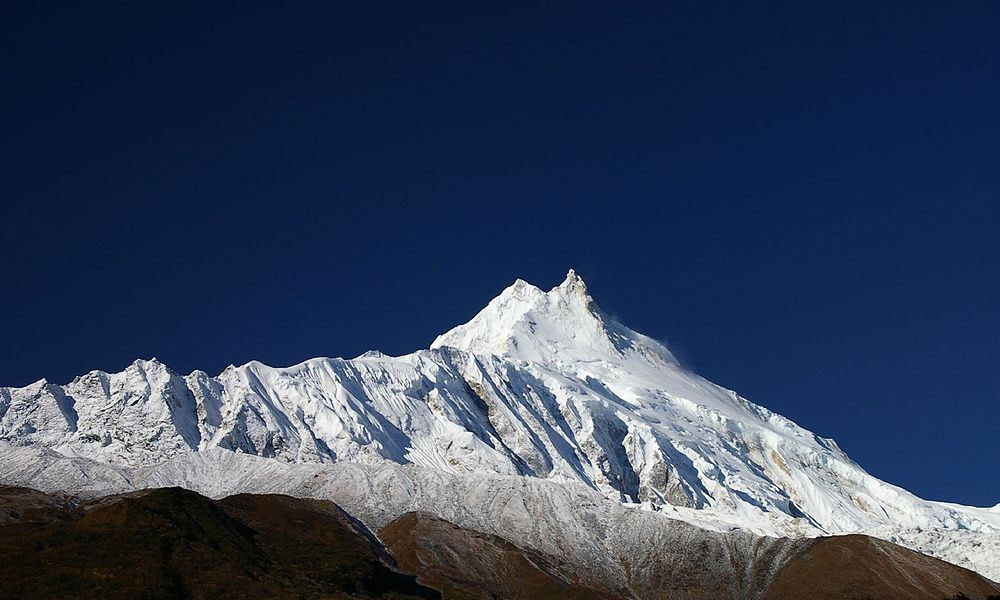
For an effective preparation for the Manaslu Circuit Trek in March, you should prepare for the few weeks prior to the actual trek. If you are not that physically active, you should consider setting the duration of your preparation to at least 3-6 weeks.
This way, your body will get used to the exercises and prepare you for the long hours of trek. Strength and cardiovascular training are the recommended preparation exercises that come in really handy while doing the trek at rising altitudes.
You can also consult with your trek guide or a physical trainer to design an ultimate training plan if you want to dedicate your free hours to training effectively.
Strength Training Exercises: Squats, bench press, deadlift, barbell row, calf raise, leg extension, bicep curl, tricep dips, glute bridge, overhead press, push up, pull up, plank, etc
Cardiovascular Exercises: Swimming, cycling, running, jumping rope, mountain climber, aerobics, burpee, jumping jack, rowing, etc
What About Accommodation?

As the bloom of the spring slowly starts to take over the marks left by the winter season, the teahouses along the trekking trail gradually start to operate at full throttle. So, you can expect the teahouses/lodges to be fully operational during your Manaslu Circuit Trek in March.
During your Manaslu Circuit Trek, you will spend 2 nights at the hotel in Kathmandu and 13 nights at teahouse/lodges in the route. You will lodge at the star hotels during your stay in Kathmandu, and of course, the services and amenities of these star hotels are top-tier.
However, during the trekking part, as the exploration takes place in the remote Himalayan region, the accommodation services are basic to moderate. Although the Manaslu trekking route has grown in popularity in recent years, it is not as well developed as the mainstream trekking route.
You will stay in warm and cozy rooms during your stay. The beds have cozy and comfortable mattresses, and you will also get blankets and pillows. Still, it will be better if you bring your sleeping bag during the trip.
Food and Water
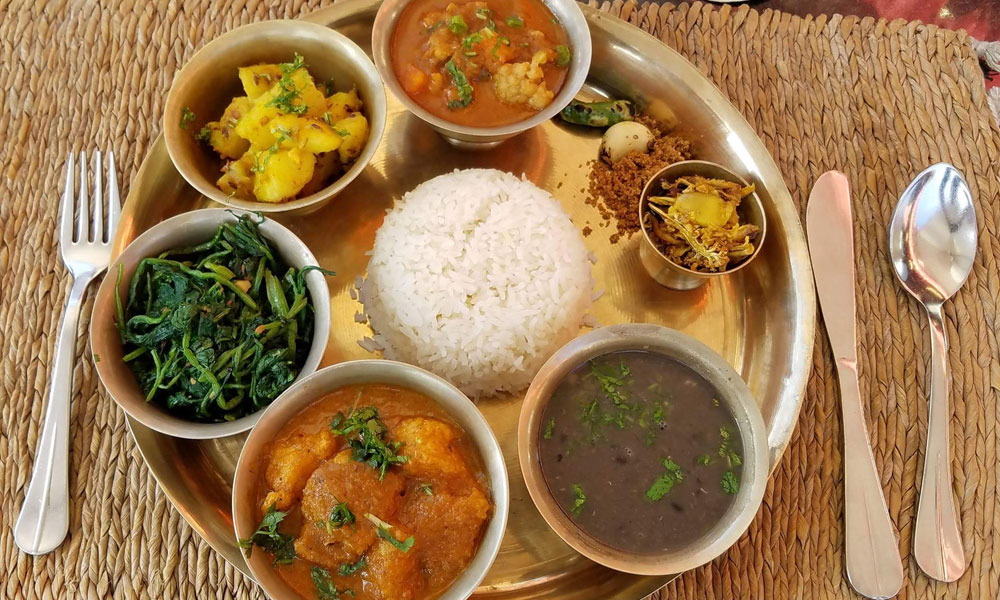
As you pass through charming settlements with diverse ethnic groups during your Manaslu Circuit Trek in March, you can expect to enjoy a wide variety of tasty delicacies. This incredible trekking adventure will introduce you to the region-specific dishes in the country that represent different cultures.
At the same time, you will also be able to enjoy other Asian cuisines, continental and other Western dishes. If you are wondering about the vegetarian and vegan meal options, don’t worry; you will be able to enjoy the meal of your preference.
Menu for Breakfast: Tibetan bread, paratha, chapati, Pakoda, bread, toasts, eggs, juice, coffee, milk, butter, honey, muesli, oats, cornflake, package, pudding, etc
Menu for Lunch and Dinner: Porridge, pizza, burger, sandwich, pasta, spaghetti, dal bhaat tarkari, dhindo, gundruk, chamati, chhoyela, thukpa, shyaphale, tingmo, tasampa, etc
Water During Trek
You will have to drink about 3-4 liters of water during your Manaslu trekking adventure. If you drink the recommended limit, the water level in your body won’t decrease significantly. Also, it will help the acclimatization process and minimize the risks of Acute Mountain Sickness (AMS).
We don’t recommend you buy canned drinks or water bottles during your trek as they affect the environment. You can carry re-suable water bottles with you and fill them up at the safe drinking stations located in the trekking route.
The water in the Himalayas is pure and safe. However, you should still purify the water to stay on the safer side. There is also an option to buy boiled and filtered water at teahouses en route. They cost approximately US$ 2 to US$ 4, depending on altitude.
Permits for Manaslu Trek
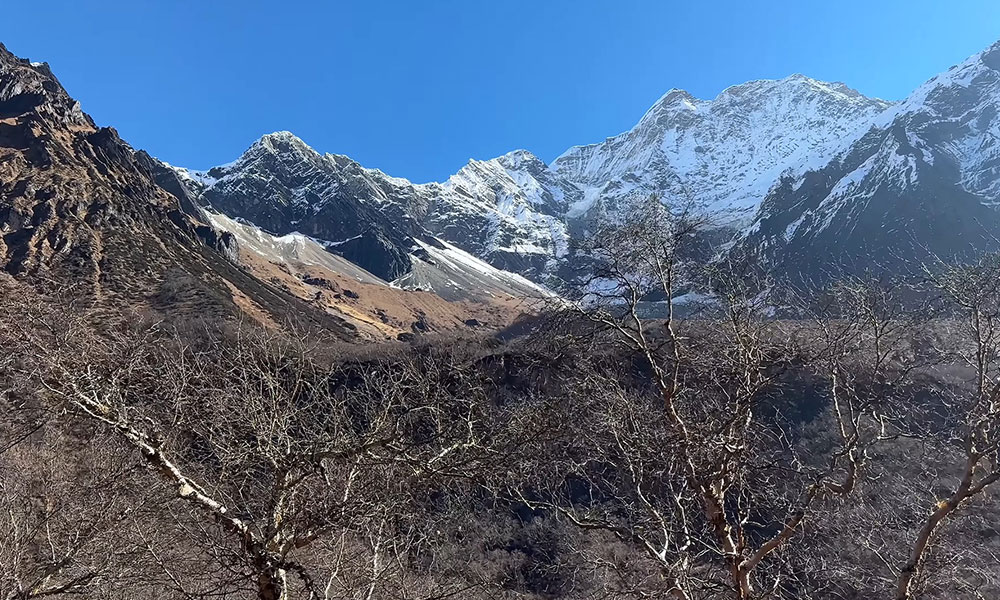
This unique Himalayan expedition takes you across the protected areas of the two major regions in the country: Manaslu and Annapurna. So, the required permit list for this exciting adventure is slightly longer than other trekking adventures in the country.
You will require the following permits for the Manaslu Circuit Trek:
- Restricted Area Permit (RAP) for Manaslu
- Manaslu Conservation Area Project (MCAP) Permit
- Annapurna Conservation Area Project (ACAP) Permit
- Trekker’s Information Management System (TIMS) Card
The costs for both MCAP and ACAP are similar; you will have to pay US$ 10 if you are a citizen of a SAARC nation and pay US$ 30 if you have other nationalities. Similarly, the TIMS Card, which is now a mandatory trekking permit in Nepal, costs about US$ 17.
Restricted Area Permit (RAP) is slightly costlier than other permits; you will have to pay US$ 100 for the permit in months from September to November (autumn season) and US$ 75 in other seasons (i.e., winter, spring, and monsoon).
Health and Safety
Our Manaslu Circuit Trek is led by government-licensed industry experts. These professionals guides have years of experience in the region and are familiar with like the back of their hands. Our guides are also well-trained in first-aid response and have also received training for high-altitude care.
So, you can rest assured and focus on the experience; our professional-dedicated team will take care of the rest. We will check your health conditions during each day of the trek and determine how well you are acclimatizing to your high-altitude destinations.
Your trekking guide will keep the head office in Kathmandu posted about the route, circumstances, and well-being of the team. So, in case of sickness and any kind of emergency, both your guide and head office will coordinate efficiently for immediate action.
What to Pack?
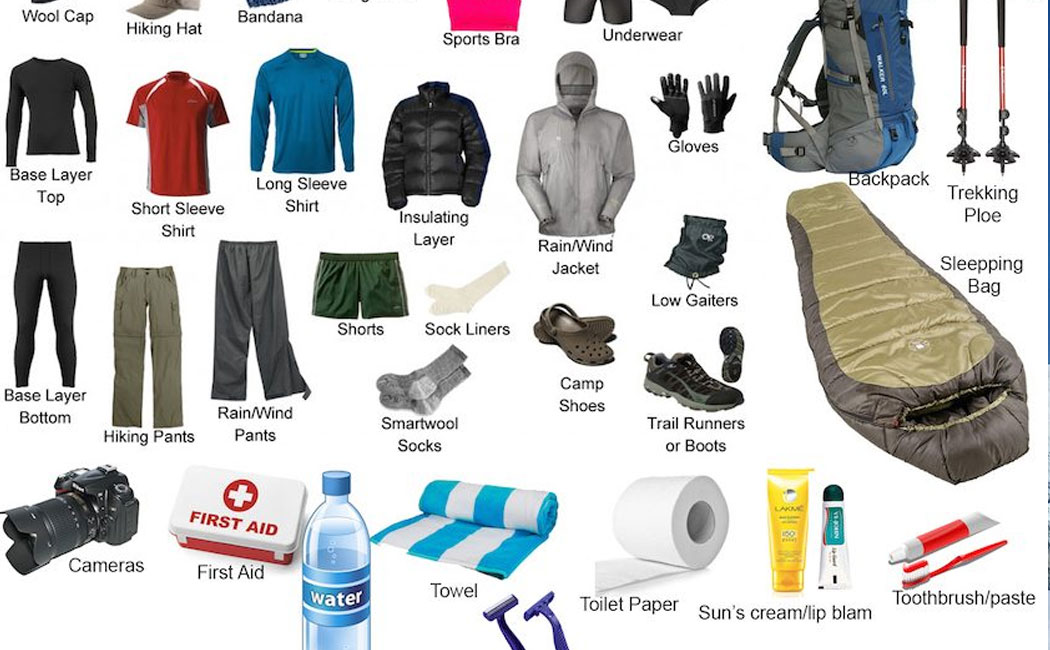
The month of March can be a bit chilly at the higher altitudes as the winter cold still lingers around during the early part of the month. But don’t worry; the lower trekking trails have warm and comfortable temperatures.
As you will traverse across diverse landscapes and different climate zones, you should pack the appropriate wear and tools to make the experience cozy. Your porters carry approximately 15 kg of your personal luggage. You will have to carry the excessive luggage by yourself. So, make sure to pack as light as possible.
Recommended Packlist
Head and Body
- Sun hat, brimmed hat
- Beanier for cold region, woolen hat
- Neck gaiter, scarf
- Moisture-wicking shirts (half and full)
- Insulated inners, warm sweaters
- Waterproof/windproof jacket
- Fleece or down jacket
- Thermal leggings
- Lightweight/quick-drying trekking pants
- Hiking shorts
- Waterproof/windproof pants
- Lightweight gloves
- Insulated-waterproof gloves
Foot
- Sturdy hiking boots (broken-in)
- Moisture-wicking socks
- Thick woolen/insulated socks
- Gaiters
- Lightweight sports shoes
- Sandals/slippers
Personal Hygiene
- Sunscreen cream
- Bar soap, shampoo
- Body lotion, lip care
- Small mirror
- Nail clippers
- Deodorants
- Foot powder
- Face wipes, tissue paper
- Toilet paper
- Sanitizer
- Bug repellent
- Water purification
- Personal medications (if any)
- First aid box
Gears/Miscellaneous
- Sleeping bag/ insulated sleeping pad
- Backpack
- Rain cover
- Trekking poles
- Camera
- Powerbank
- Map and compass
- Ankle support
- Universal charger
- Binoculars
- Journals, magazines
- Cash
- Snacks
You may also like:
Is This Trek Suitable for Me?
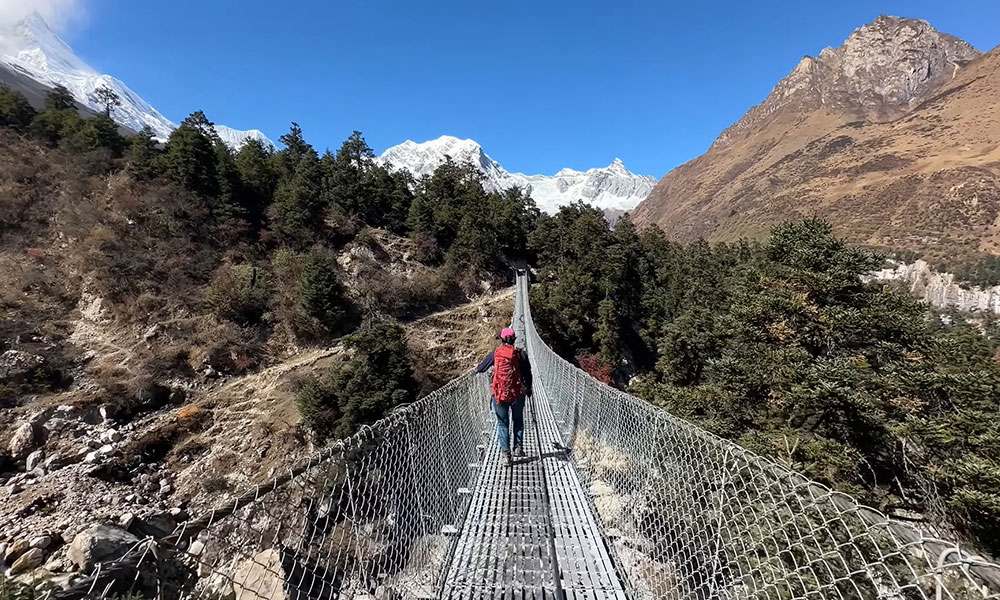
The Manaslu Circuit Trek is of a mild difficulty nature. It is certainly one of the most exciting trekking routes if you want to experience the tranquil magnificence of the Himalayas away from the mainstream crowd.
So, if you are worried about whether you can do this trek or not, don’t worry, with enough willpower, people can even mountains. Due to its moderate nature, you neither need a top physical shape nor any kind of technical skills.
But, still it will be helpful if you don’t slack off on training for the trek. A basic fitness level and good health condition are plentiful for you to complete this trek without any issues. The success rate of this remarkable Himalayan trekking expedition is around 98% to 100%, which says a lot about the overall difficulty level.
Also, there are no age-specific restrictions for the Manaslu Circuit Trek, and in the past, this route has been conquered by children and older trekkers. So, if you are willing to do this trek and won’t mind putting effort into training, you are bound to have an unforgettable Himalayan experience.
Some Helpful Tips for Your Manaslu Circuit Trek in March
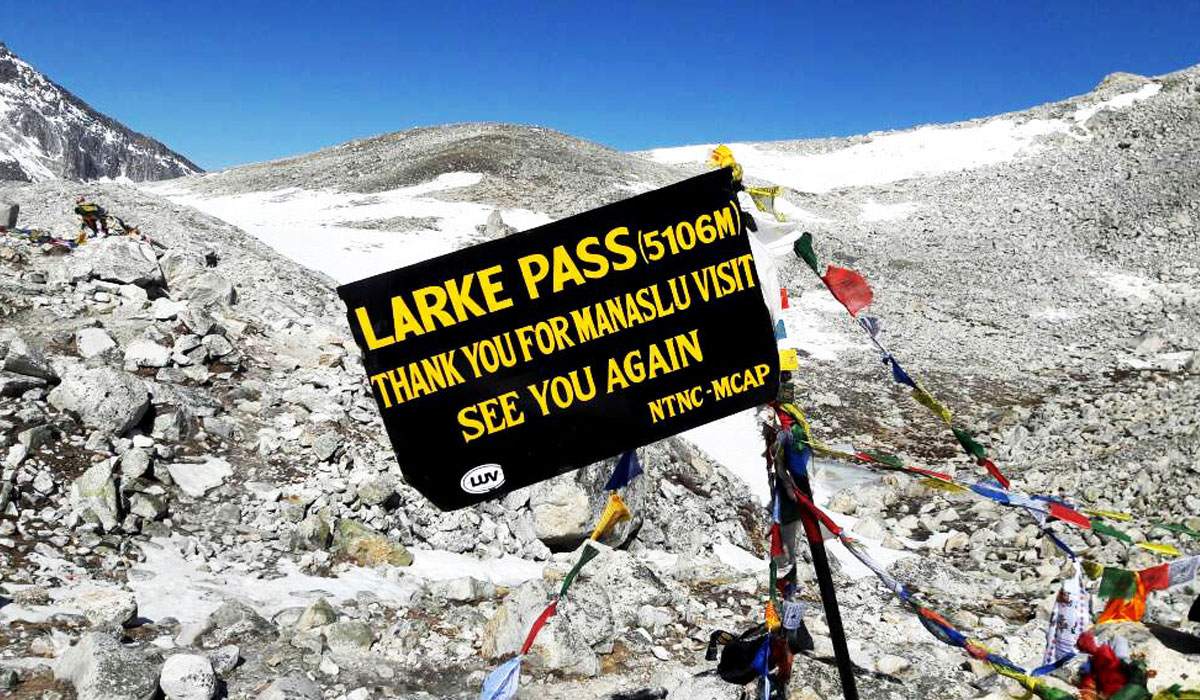
- Train adequately; the more you train, the more comfortable the experience you can enjoy
- Don’t forget the mental preparation and visualization
- Stay hydrated, and don’t forget to pack electrolytes for the journey
- Take it slow; it’s not a marathon; enjoy the trek at your own pace
- Gather all the necessary information about the region, read about the experience of the trekkers
- Monitor your diet, especially at high altitudes where you can feel the loss of appetite
- Avoid alcohol and cigarettes if possible; they are known to complicate the acclimatization procedure
- Pack altitude sickness medications; you can also use the oxygen bottles if necessary
- Communicate with your guide if you are dealing with any kind of problems or difficulties
- Strictly stick to the guidelines and suggestions of the guide and porters
- Stay safe and enjoy!

